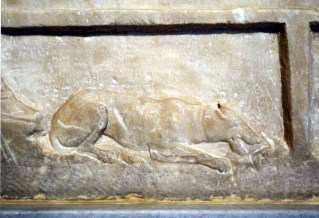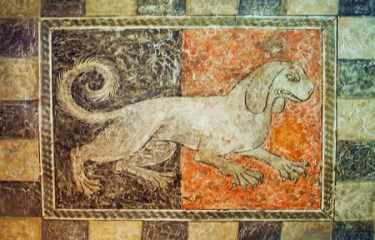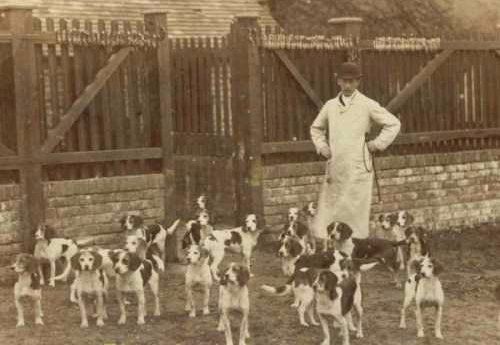Beagle Origin

Votive relief dispicting a dog in 5th century BC, Athens - the Beagle's ancestor.
Attribution: By Giovanni Dall'Orto (Own work), via Wikimedia Commons
Overview
Did you ever wonder where the Beagle breed came from and what took place in Beagle history? It took quite a long time for the modern breed to be created. Let’s see where this all began and each step that happened to bring us the Beagle we know and love today.
5th Century
To begin, we must look back over a thousand and one-half years. The history of the Beagle begins with the dog's ancestors who originated in Ancient Greece. Dogs of similar size and purpose (hunting) to the modern Beagle can be traced back to the 5th century in Ancient Greece.
8th Century
In the 8th century there was a breed known as the St. Hubert Hound, which was a scent hound (a hound dog used for hunting). From this St. Hubert Hound, a newer breed was created: the Talbot Hound. The Talbot had a mostly white coat of fur and a very deep bark. Its one feature that did not serve well for hunting, was that this dog was a rather slow runner.
11th Century - The Move Into England
In the 11th century, William the Conqueror brought the Talbot Hound to England. It is believed that the Talbot Hound was then bred with the Greyhound. This was in an effort to give the Talbot Hound more speed when running.
Once this new dog breed was created, it was called the Southern Hound which, in turn, is thought to be an ancestor of today’s Beagle.

This Talbot Dog was painted on the ceiling of Sir Henry Vernon's (1445-1515) home.
Attribution: Unknown painter in 16th century Français : Peintre inconnu du XVIè siècle (Haddon Hall Photo Gallery) [Public domain],
via Wikimedia Commons
The Now Extinct Pocket Beagle
During medieval times, the word “beagle” meant any dog that was a hound dog. At that time, there were very small hound dogs and they were called “Pocket Beagles”. They were only 8 to 9 inches (20 – 23 cm) from ground to shoulder.
King Henry VII and Queen Elizabeth I were known for their love of this miniature breed. They were called “Pocket Beagles” because they were small enough to fit into the pockets of men who hunted. Once larger dogs found the prey, these little dogs were let loose to continue the chase through thick brush; a place where the larger dogs could not easily get through.
As the year 1900 approached, this small Pocket Beagle became extinct. All genetic lines are no longer in existence.
The 1700's
By the 1700s two dog breeds had been developed for hunting hare and rabbit:
• The Southern Hound (as mentioned above)
• The North Country Beagle (or Northern Hound).
The Southern Hound, in comparison to today’s Beagle, was tall and heavy. It did have long, soft ears
just like today’s Beagle.
The North Country Beagle was smaller than the Southern Hound, and had a more pointed muzzle. It was faster than the Southern Hound; but its scenting abilities were not as good as the Southern Hound.
As fox hunting became very popular, both of these 2 dog breeds were then bred with the Foxhound to create a “perfect" hunting dog.
1830
In the year 1830, Reverend Phillip Honeywood of Great Britain, established a breeding program. It is believed that this formed the basis for the modern Beagle breed.
The North Country Beagles and Southern Hounds were involved. Records on this were not kept, therefore one can only speculate as to other breeds that were used. The first new Beagle that was created were the Honeywood’s Beagles. These were still different than today’s Beagle; they were smaller and had a pure white coat.
Still wanting to create a better breed, a man by the name of Thomas Johnson worked on producing dogs that had a great appearance and were also great hunters. His work lead to two different breeds: One with a rough coat of fur and one with a smooth coat of fur.
The rough-coated Beagle survived until the beginning of the 20th century, and there were even records of one making an appearance at a dog show as late as 1969, but this variety is now extinct.
1840
In the 1840s, a standard Beagle type was beginning to develop: the distinction between the North Country Beagle and Southern Hound had been lost, but there was still a large variation in size, character, and reliability among the new Beagles.
At this time, there were four different types: The medium Beagle; the dwarf or lapdog Beagle; the fox Beagle (a smaller, slower version of the Foxhound); and the rough-coated or terrier Beagle.
1887
In 1887, there were only 18 “packs” in England. Those who loved the breed were determined to not allow any of the Beagles to become extinct as previous Beagle-type breeds had become.
1890-1902
The Beagle Club was formed in 1890 and the first standard of the Beagle was written. The following year the Association of Masters of Harriers and Beagles was formed. Both organizations aimed to further the best interests of the breed, and both wanted to produce one standard type of Beagle. By 1902 the number of packs had risen from 18 to 44.

Remarkable photo of the Caynsham Beagle Pack from 1885
Attribution: Author Unknown;[Public domain], via Wikimedia Commons
The Move Into America
General Richard Rowett from Illinois, USA imported some dogs from England and began breeding. Rowett's Beagles are believed to be the models for the first American standard. The Beagle was accepted as a breed by the American Kennel Club (AKC) in 1884. In the 20th century the breed has spread worldwide as a very popular dog. Now, the Beagle was not just used for hunting; the Beagle became a wonderful family pet.
Today's Beagle
The Beagle is considered to be one of the worlds' most popular breeds, popular in a vast majority of countries in which pet ownership is commonplace. Due to his loving and loyal personality, friendly way with children, lower-than-average
grooming maintenance and wonderful temperament, you will find plenty of Beagles everywhere from London flats, to farms in Idaho to high-rises in New York.
Some breeders will advertise that they have “Pocket Beagles”; however there is no such breed. Sometimes, in an attempt to make people believe that “Pocket Beagles” still exist, unethical breeders will try to produce dogs that are much smaller than nature intended.
Beagles that are smaller than the breed standard are “created” by breeding together 2 “runt” dogs. They are continually “bred down” to an unhealthy size. This can lead to many health issues. In other cases, a breeder may falsify the age of a puppy or simply call a Beagle a “Pocket Beagle” when the dog will grow to be normal size.
There is only one official Beagle breed across the world. Some clubs recognize 2 sizes of Beagles and some just one; but all do not recognize any “Pocket Beagle” or any other term that would imply a tiny breed.
You may also be interested in:
Beagle Behavior
- Expected temperament and personality of this breed. Covers both young pups and adult Beagle dogs.
Apartment living with the Beagle
- Learn if this dog that loves being outdoors and requires a lot of exercise to satisfy his high energy would be able to do okay in a small apartment.
Beagle Pictures
- The Cutest Beagle Photo Gallery, is packed with super cute photos of Beagles of all ages.


